Financial Reporting: Implementation of GAAP in Business Practices
VerifiedAdded on 2020/05/28
|9
|1760
|173
Report
AI Summary
This report comprehensively examines the implementation of Generally Accepted Accounting Principles (GAAP) in business practices and financial reporting, using Alumina Limited Company as a primary case study. The paper begins by outlining the fundamental accounting guidelines and principles that underpin legal accounting rules, emphasizing the role of GAAP as mandated by the Australian Accounting Standards Board, which ensures financial statements align with International Financial Reporting Standards (IFRS). The report details how to identify income, including revenue recognition and measurement, and highlights the significance of GAAP in Alumina Limited's financial statements, covering both measurement and recognition conditions. It further analyzes the valuation and performance implications when GAAP is not adhered to. The study emphasizes the importance of GAAP for reliable financial information, facilitating informed decisions by investors and lenders, and simplifying the transition from private to public company status. Additionally, the report includes an analysis of how Alumina Limited implements GAAP through disclosure and measurement principles, the role of accountants in interpreting GAAP, and the use of both GAAP and non-GAAP measures. The conclusion reiterates the impact of GAAP on financial statements and the importance of transparent reconciliation between GAAP and non-GAAP results.
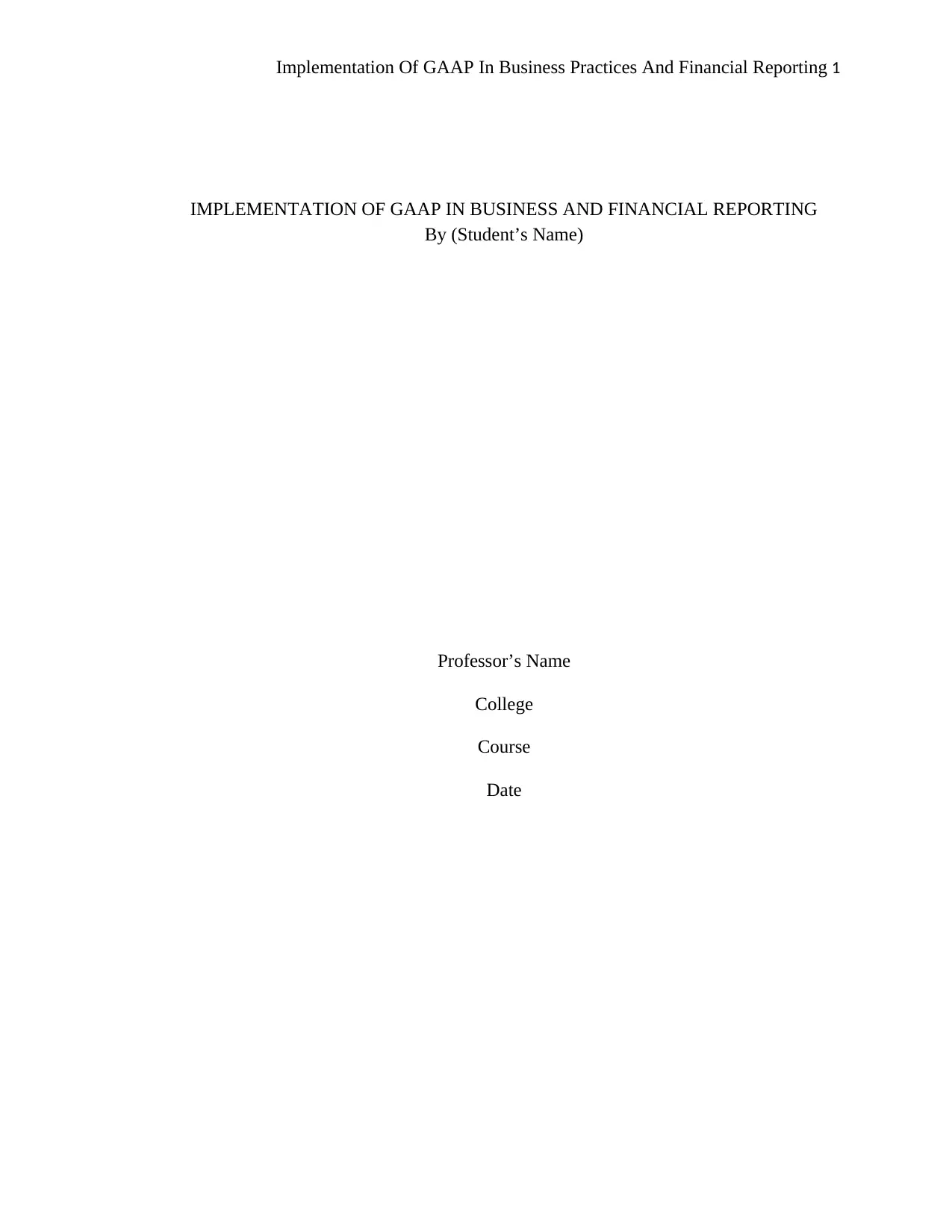
Implementation Of GAAP In Business Practices And Financial Reporting 1
IMPLEMENTATION OF GAAP IN BUSINESS AND FINANCIAL REPORTING
By (Student’s Name)
Professor’s Name
College
Course
Date
IMPLEMENTATION OF GAAP IN BUSINESS AND FINANCIAL REPORTING
By (Student’s Name)
Professor’s Name
College
Course
Date
Paraphrase This Document
Need a fresh take? Get an instant paraphrase of this document with our AI Paraphraser
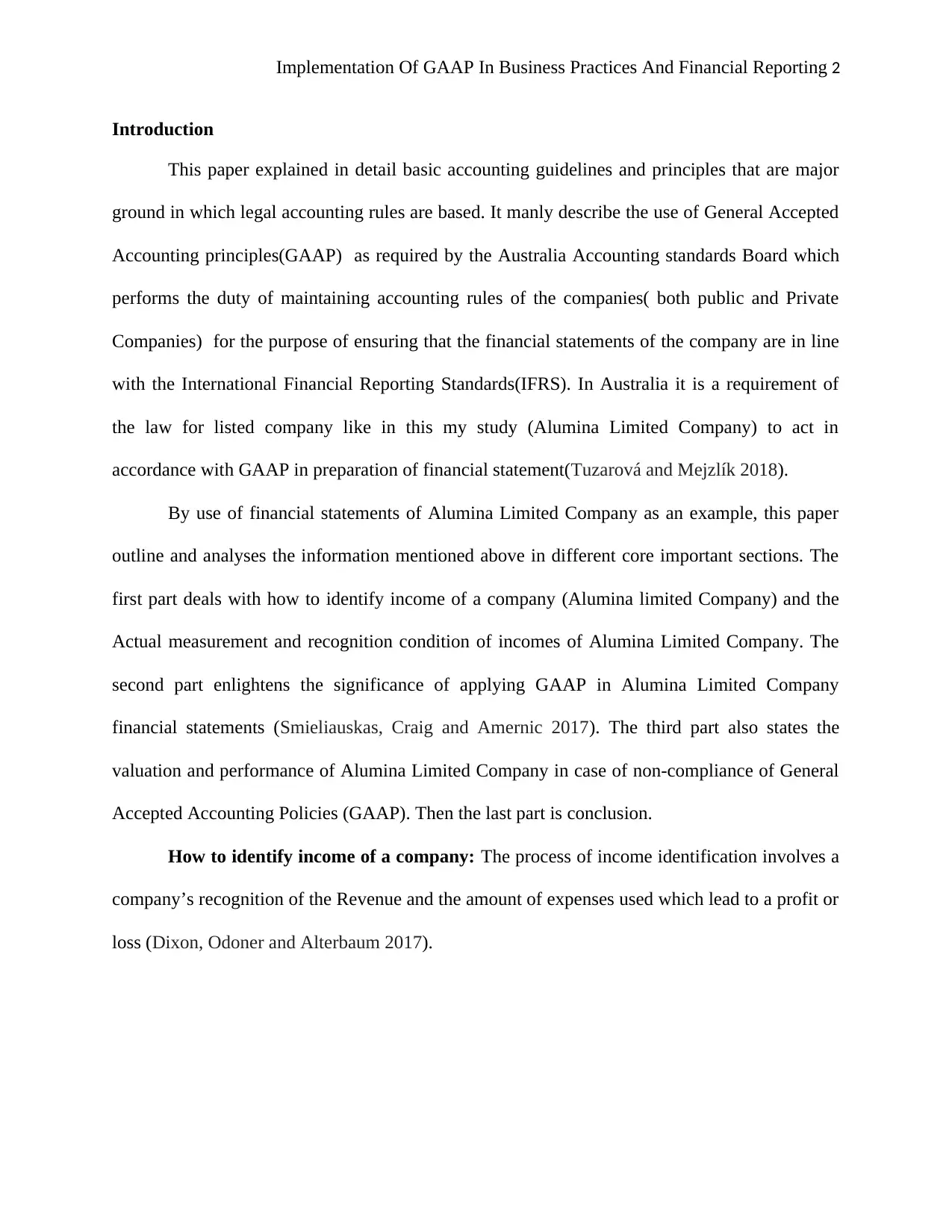
Implementation Of GAAP In Business Practices And Financial Reporting 2
Introduction
This paper explained in detail basic accounting guidelines and principles that are major
ground in which legal accounting rules are based. It manly describe the use of General Accepted
Accounting principles(GAAP) as required by the Australia Accounting standards Board which
performs the duty of maintaining accounting rules of the companies( both public and Private
Companies) for the purpose of ensuring that the financial statements of the company are in line
with the International Financial Reporting Standards(IFRS). In Australia it is a requirement of
the law for listed company like in this my study (Alumina Limited Company) to act in
accordance with GAAP in preparation of financial statement(Tuzarová and Mejzlík 2018).
By use of financial statements of Alumina Limited Company as an example, this paper
outline and analyses the information mentioned above in different core important sections. The
first part deals with how to identify income of a company (Alumina limited Company) and the
Actual measurement and recognition condition of incomes of Alumina Limited Company. The
second part enlightens the significance of applying GAAP in Alumina Limited Company
financial statements (Smieliauskas, Craig and Amernic 2017). The third part also states the
valuation and performance of Alumina Limited Company in case of non-compliance of General
Accepted Accounting Policies (GAAP). Then the last part is conclusion.
How to identify income of a company: The process of income identification involves a
company’s recognition of the Revenue and the amount of expenses used which lead to a profit or
loss (Dixon, Odoner and Alterbaum 2017).
Introduction
This paper explained in detail basic accounting guidelines and principles that are major
ground in which legal accounting rules are based. It manly describe the use of General Accepted
Accounting principles(GAAP) as required by the Australia Accounting standards Board which
performs the duty of maintaining accounting rules of the companies( both public and Private
Companies) for the purpose of ensuring that the financial statements of the company are in line
with the International Financial Reporting Standards(IFRS). In Australia it is a requirement of
the law for listed company like in this my study (Alumina Limited Company) to act in
accordance with GAAP in preparation of financial statement(Tuzarová and Mejzlík 2018).
By use of financial statements of Alumina Limited Company as an example, this paper
outline and analyses the information mentioned above in different core important sections. The
first part deals with how to identify income of a company (Alumina limited Company) and the
Actual measurement and recognition condition of incomes of Alumina Limited Company. The
second part enlightens the significance of applying GAAP in Alumina Limited Company
financial statements (Smieliauskas, Craig and Amernic 2017). The third part also states the
valuation and performance of Alumina Limited Company in case of non-compliance of General
Accepted Accounting Policies (GAAP). Then the last part is conclusion.
How to identify income of a company: The process of income identification involves a
company’s recognition of the Revenue and the amount of expenses used which lead to a profit or
loss (Dixon, Odoner and Alterbaum 2017).
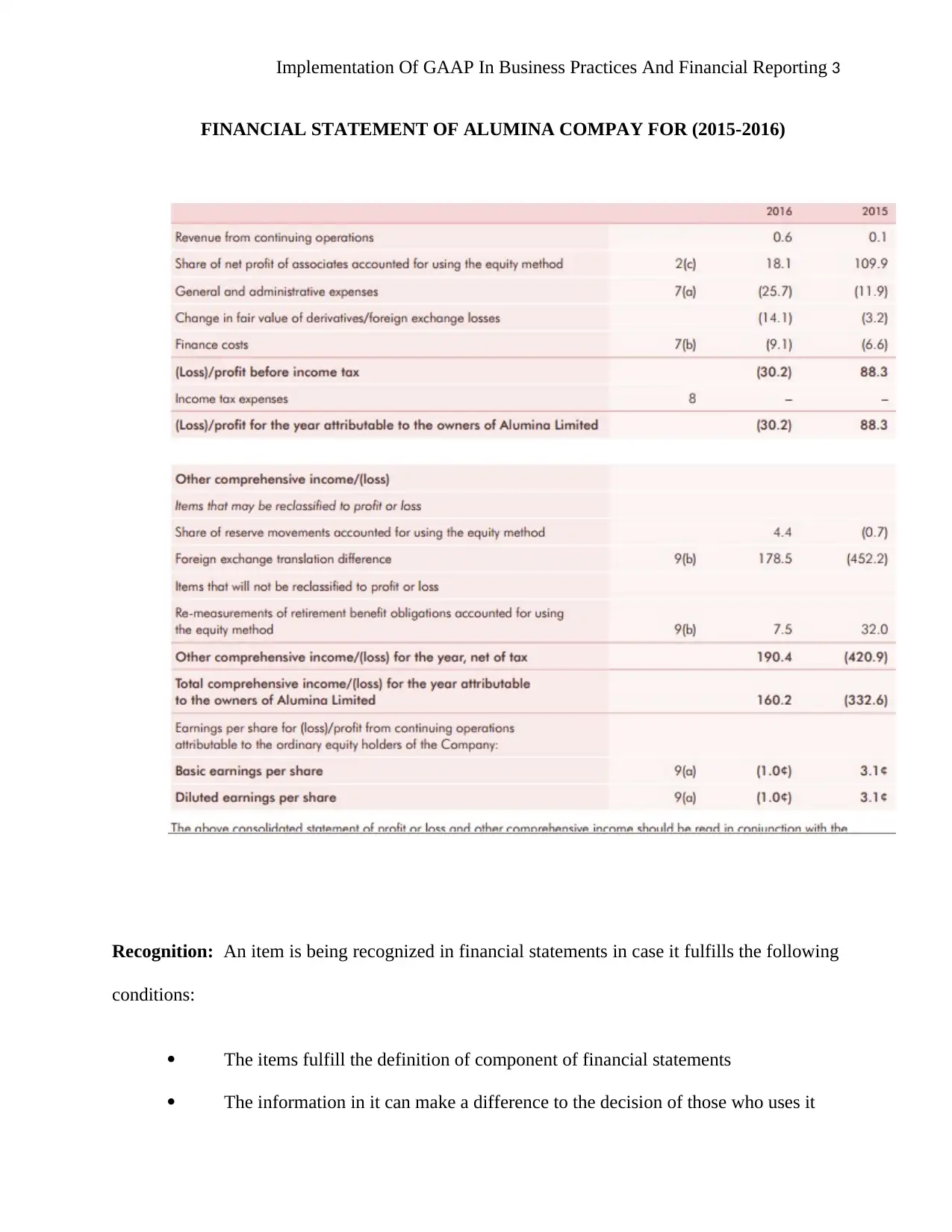
Implementation Of GAAP In Business Practices And Financial Reporting 3
FINANCIAL STATEMENT OF ALUMINA COMPAY FOR (2015-2016)
Recognition: An item is being recognized in financial statements in case it fulfills the following
conditions:
The items fulfill the definition of component of financial statements
The information in it can make a difference to the decision of those who uses it
FINANCIAL STATEMENT OF ALUMINA COMPAY FOR (2015-2016)
Recognition: An item is being recognized in financial statements in case it fulfills the following
conditions:
The items fulfill the definition of component of financial statements
The information in it can make a difference to the decision of those who uses it
⊘ This is a preview!⊘
Do you want full access?
Subscribe today to unlock all pages.

Trusted by 1+ million students worldwide
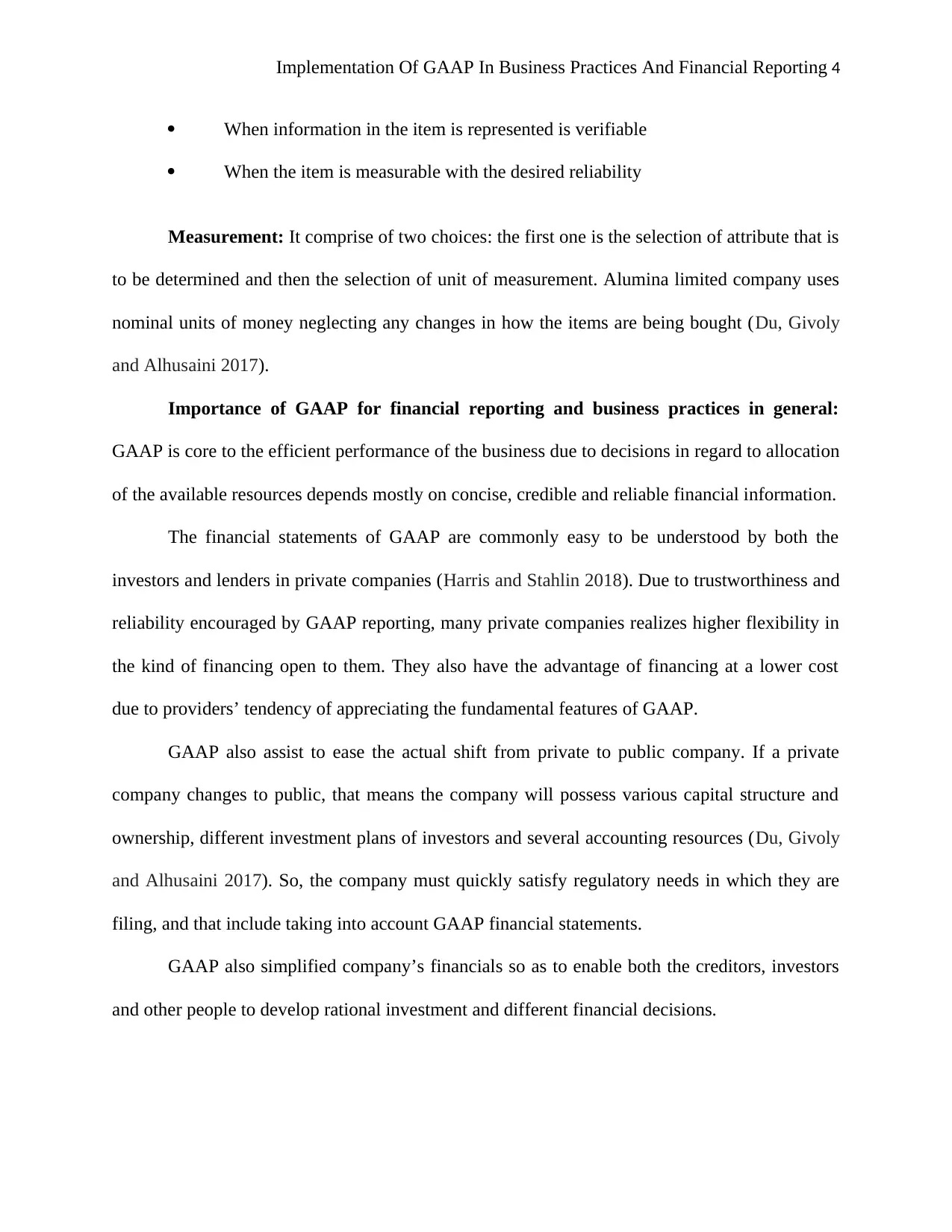
Implementation Of GAAP In Business Practices And Financial Reporting 4
When information in the item is represented is verifiable
When the item is measurable with the desired reliability
Measurement: It comprise of two choices: the first one is the selection of attribute that is
to be determined and then the selection of unit of measurement. Alumina limited company uses
nominal units of money neglecting any changes in how the items are being bought (Du, Givoly
and Alhusaini 2017).
Importance of GAAP for financial reporting and business practices in general:
GAAP is core to the efficient performance of the business due to decisions in regard to allocation
of the available resources depends mostly on concise, credible and reliable financial information.
The financial statements of GAAP are commonly easy to be understood by both the
investors and lenders in private companies (Harris and Stahlin 2018). Due to trustworthiness and
reliability encouraged by GAAP reporting, many private companies realizes higher flexibility in
the kind of financing open to them. They also have the advantage of financing at a lower cost
due to providers’ tendency of appreciating the fundamental features of GAAP.
GAAP also assist to ease the actual shift from private to public company. If a private
company changes to public, that means the company will possess various capital structure and
ownership, different investment plans of investors and several accounting resources (Du, Givoly
and Alhusaini 2017). So, the company must quickly satisfy regulatory needs in which they are
filing, and that include taking into account GAAP financial statements.
GAAP also simplified company’s financials so as to enable both the creditors, investors
and other people to develop rational investment and different financial decisions.
When information in the item is represented is verifiable
When the item is measurable with the desired reliability
Measurement: It comprise of two choices: the first one is the selection of attribute that is
to be determined and then the selection of unit of measurement. Alumina limited company uses
nominal units of money neglecting any changes in how the items are being bought (Du, Givoly
and Alhusaini 2017).
Importance of GAAP for financial reporting and business practices in general:
GAAP is core to the efficient performance of the business due to decisions in regard to allocation
of the available resources depends mostly on concise, credible and reliable financial information.
The financial statements of GAAP are commonly easy to be understood by both the
investors and lenders in private companies (Harris and Stahlin 2018). Due to trustworthiness and
reliability encouraged by GAAP reporting, many private companies realizes higher flexibility in
the kind of financing open to them. They also have the advantage of financing at a lower cost
due to providers’ tendency of appreciating the fundamental features of GAAP.
GAAP also assist to ease the actual shift from private to public company. If a private
company changes to public, that means the company will possess various capital structure and
ownership, different investment plans of investors and several accounting resources (Du, Givoly
and Alhusaini 2017). So, the company must quickly satisfy regulatory needs in which they are
filing, and that include taking into account GAAP financial statements.
GAAP also simplified company’s financials so as to enable both the creditors, investors
and other people to develop rational investment and different financial decisions.
Paraphrase This Document
Need a fresh take? Get an instant paraphrase of this document with our AI Paraphraser
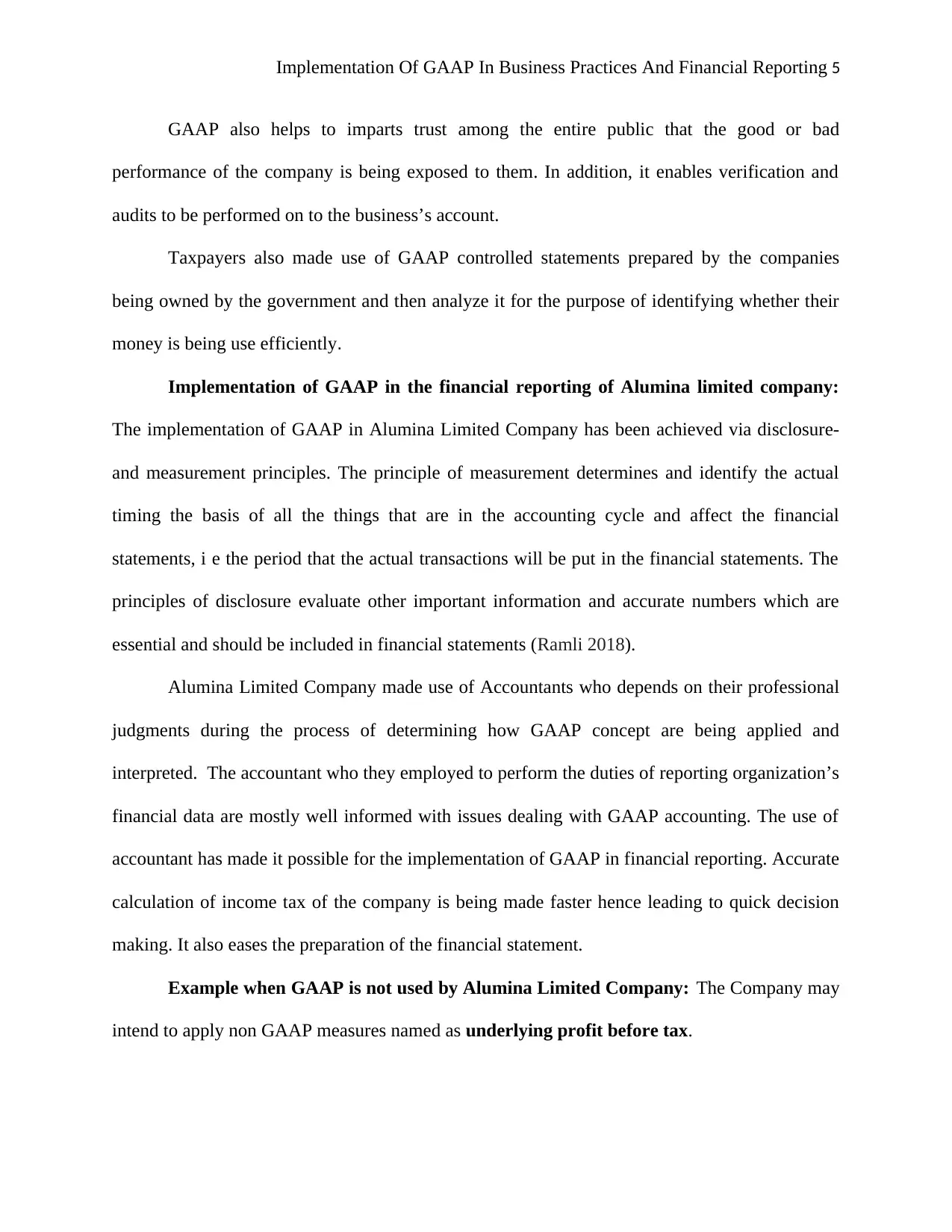
Implementation Of GAAP In Business Practices And Financial Reporting 5
GAAP also helps to imparts trust among the entire public that the good or bad
performance of the company is being exposed to them. In addition, it enables verification and
audits to be performed on to the business’s account.
Taxpayers also made use of GAAP controlled statements prepared by the companies
being owned by the government and then analyze it for the purpose of identifying whether their
money is being use efficiently.
Implementation of GAAP in the financial reporting of Alumina limited company:
The implementation of GAAP in Alumina Limited Company has been achieved via disclosure-
and measurement principles. The principle of measurement determines and identify the actual
timing the basis of all the things that are in the accounting cycle and affect the financial
statements, i e the period that the actual transactions will be put in the financial statements. The
principles of disclosure evaluate other important information and accurate numbers which are
essential and should be included in financial statements (Ramli 2018).
Alumina Limited Company made use of Accountants who depends on their professional
judgments during the process of determining how GAAP concept are being applied and
interpreted. The accountant who they employed to perform the duties of reporting organization’s
financial data are mostly well informed with issues dealing with GAAP accounting. The use of
accountant has made it possible for the implementation of GAAP in financial reporting. Accurate
calculation of income tax of the company is being made faster hence leading to quick decision
making. It also eases the preparation of the financial statement.
Example when GAAP is not used by Alumina Limited Company: The Company may
intend to apply non GAAP measures named as underlying profit before tax.
GAAP also helps to imparts trust among the entire public that the good or bad
performance of the company is being exposed to them. In addition, it enables verification and
audits to be performed on to the business’s account.
Taxpayers also made use of GAAP controlled statements prepared by the companies
being owned by the government and then analyze it for the purpose of identifying whether their
money is being use efficiently.
Implementation of GAAP in the financial reporting of Alumina limited company:
The implementation of GAAP in Alumina Limited Company has been achieved via disclosure-
and measurement principles. The principle of measurement determines and identify the actual
timing the basis of all the things that are in the accounting cycle and affect the financial
statements, i e the period that the actual transactions will be put in the financial statements. The
principles of disclosure evaluate other important information and accurate numbers which are
essential and should be included in financial statements (Ramli 2018).
Alumina Limited Company made use of Accountants who depends on their professional
judgments during the process of determining how GAAP concept are being applied and
interpreted. The accountant who they employed to perform the duties of reporting organization’s
financial data are mostly well informed with issues dealing with GAAP accounting. The use of
accountant has made it possible for the implementation of GAAP in financial reporting. Accurate
calculation of income tax of the company is being made faster hence leading to quick decision
making. It also eases the preparation of the financial statement.
Example when GAAP is not used by Alumina Limited Company: The Company may
intend to apply non GAAP measures named as underlying profit before tax.
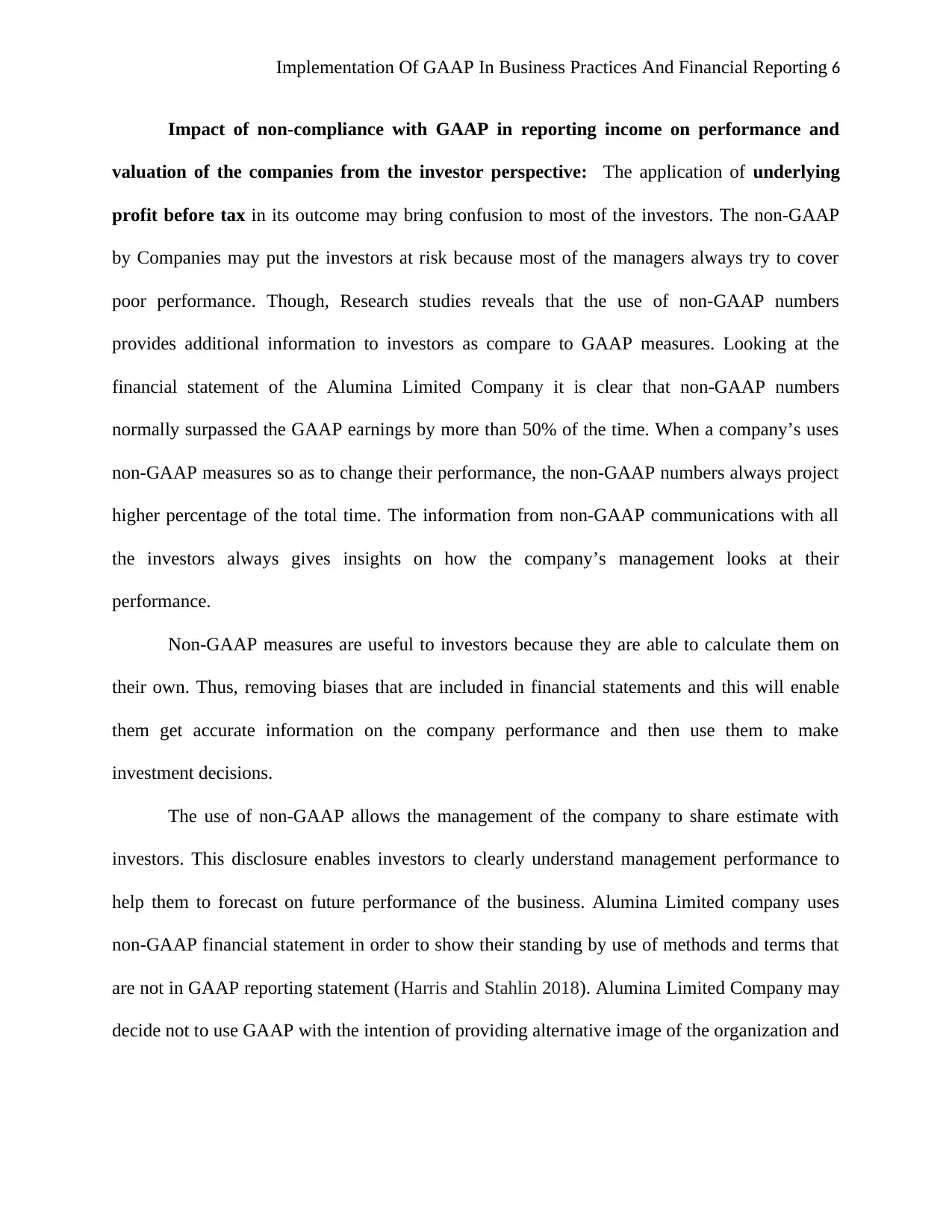
Implementation Of GAAP In Business Practices And Financial Reporting 6
Impact of non-compliance with GAAP in reporting income on performance and
valuation of the companies from the investor perspective: The application of underlying
profit before tax in its outcome may bring confusion to most of the investors. The non-GAAP
by Companies may put the investors at risk because most of the managers always try to cover
poor performance. Though, Research studies reveals that the use of non-GAAP numbers
provides additional information to investors as compare to GAAP measures. Looking at the
financial statement of the Alumina Limited Company it is clear that non-GAAP numbers
normally surpassed the GAAP earnings by more than 50% of the time. When a company’s uses
non-GAAP measures so as to change their performance, the non-GAAP numbers always project
higher percentage of the total time. The information from non-GAAP communications with all
the investors always gives insights on how the company’s management looks at their
performance.
Non-GAAP measures are useful to investors because they are able to calculate them on
their own. Thus, removing biases that are included in financial statements and this will enable
them get accurate information on the company performance and then use them to make
investment decisions.
The use of non-GAAP allows the management of the company to share estimate with
investors. This disclosure enables investors to clearly understand management performance to
help them to forecast on future performance of the business. Alumina Limited company uses
non-GAAP financial statement in order to show their standing by use of methods and terms that
are not in GAAP reporting statement (Harris and Stahlin 2018). Alumina Limited Company may
decide not to use GAAP with the intention of providing alternative image of the organization and
Impact of non-compliance with GAAP in reporting income on performance and
valuation of the companies from the investor perspective: The application of underlying
profit before tax in its outcome may bring confusion to most of the investors. The non-GAAP
by Companies may put the investors at risk because most of the managers always try to cover
poor performance. Though, Research studies reveals that the use of non-GAAP numbers
provides additional information to investors as compare to GAAP measures. Looking at the
financial statement of the Alumina Limited Company it is clear that non-GAAP numbers
normally surpassed the GAAP earnings by more than 50% of the time. When a company’s uses
non-GAAP measures so as to change their performance, the non-GAAP numbers always project
higher percentage of the total time. The information from non-GAAP communications with all
the investors always gives insights on how the company’s management looks at their
performance.
Non-GAAP measures are useful to investors because they are able to calculate them on
their own. Thus, removing biases that are included in financial statements and this will enable
them get accurate information on the company performance and then use them to make
investment decisions.
The use of non-GAAP allows the management of the company to share estimate with
investors. This disclosure enables investors to clearly understand management performance to
help them to forecast on future performance of the business. Alumina Limited company uses
non-GAAP financial statement in order to show their standing by use of methods and terms that
are not in GAAP reporting statement (Harris and Stahlin 2018). Alumina Limited Company may
decide not to use GAAP with the intention of providing alternative image of the organization and
⊘ This is a preview!⊘
Do you want full access?
Subscribe today to unlock all pages.

Trusted by 1+ million students worldwide
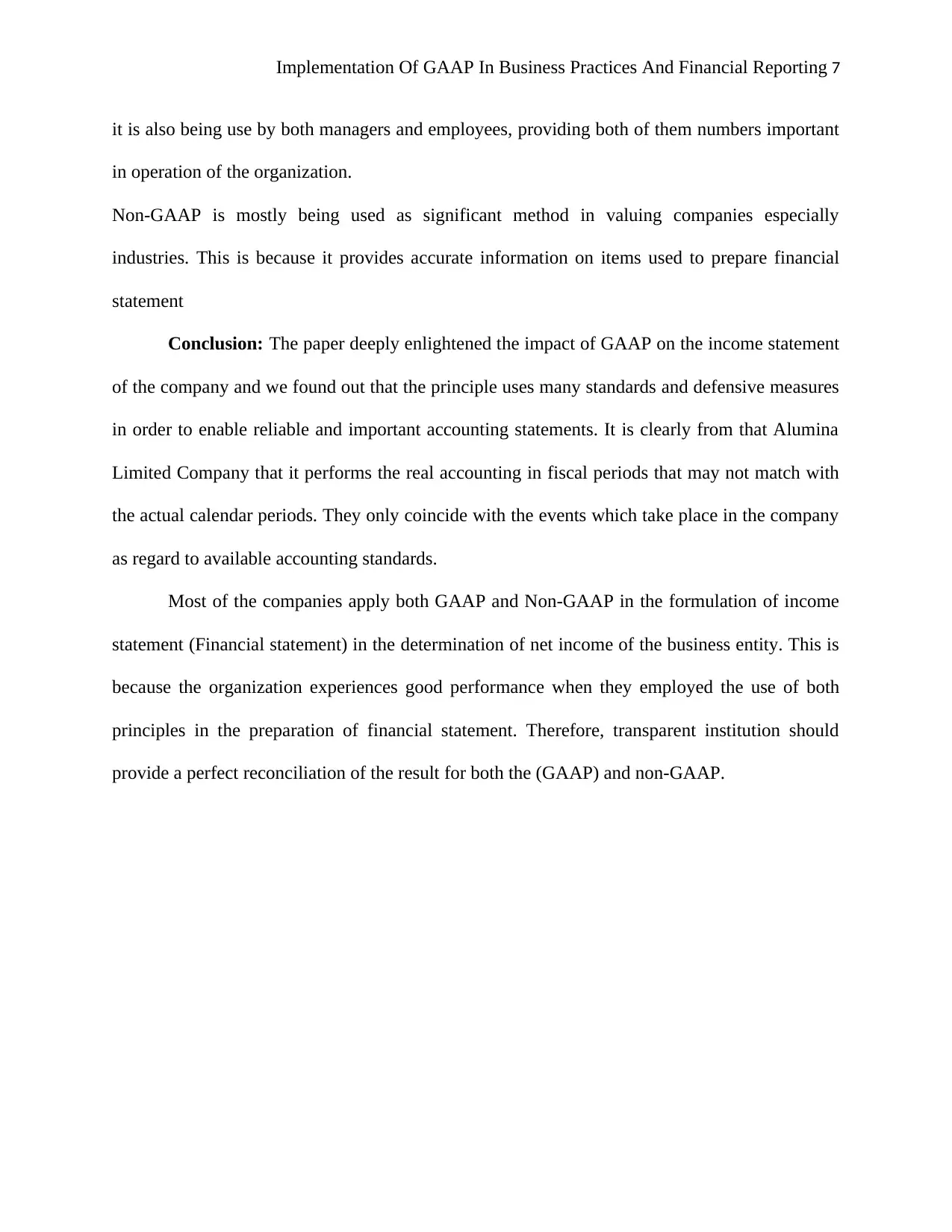
Implementation Of GAAP In Business Practices And Financial Reporting 7
it is also being use by both managers and employees, providing both of them numbers important
in operation of the organization.
Non-GAAP is mostly being used as significant method in valuing companies especially
industries. This is because it provides accurate information on items used to prepare financial
statement
Conclusion: The paper deeply enlightened the impact of GAAP on the income statement
of the company and we found out that the principle uses many standards and defensive measures
in order to enable reliable and important accounting statements. It is clearly from that Alumina
Limited Company that it performs the real accounting in fiscal periods that may not match with
the actual calendar periods. They only coincide with the events which take place in the company
as regard to available accounting standards.
Most of the companies apply both GAAP and Non-GAAP in the formulation of income
statement (Financial statement) in the determination of net income of the business entity. This is
because the organization experiences good performance when they employed the use of both
principles in the preparation of financial statement. Therefore, transparent institution should
provide a perfect reconciliation of the result for both the (GAAP) and non-GAAP.
it is also being use by both managers and employees, providing both of them numbers important
in operation of the organization.
Non-GAAP is mostly being used as significant method in valuing companies especially
industries. This is because it provides accurate information on items used to prepare financial
statement
Conclusion: The paper deeply enlightened the impact of GAAP on the income statement
of the company and we found out that the principle uses many standards and defensive measures
in order to enable reliable and important accounting statements. It is clearly from that Alumina
Limited Company that it performs the real accounting in fiscal periods that may not match with
the actual calendar periods. They only coincide with the events which take place in the company
as regard to available accounting standards.
Most of the companies apply both GAAP and Non-GAAP in the formulation of income
statement (Financial statement) in the determination of net income of the business entity. This is
because the organization experiences good performance when they employed the use of both
principles in the preparation of financial statement. Therefore, transparent institution should
provide a perfect reconciliation of the result for both the (GAAP) and non-GAAP.
Paraphrase This Document
Need a fresh take? Get an instant paraphrase of this document with our AI Paraphraser
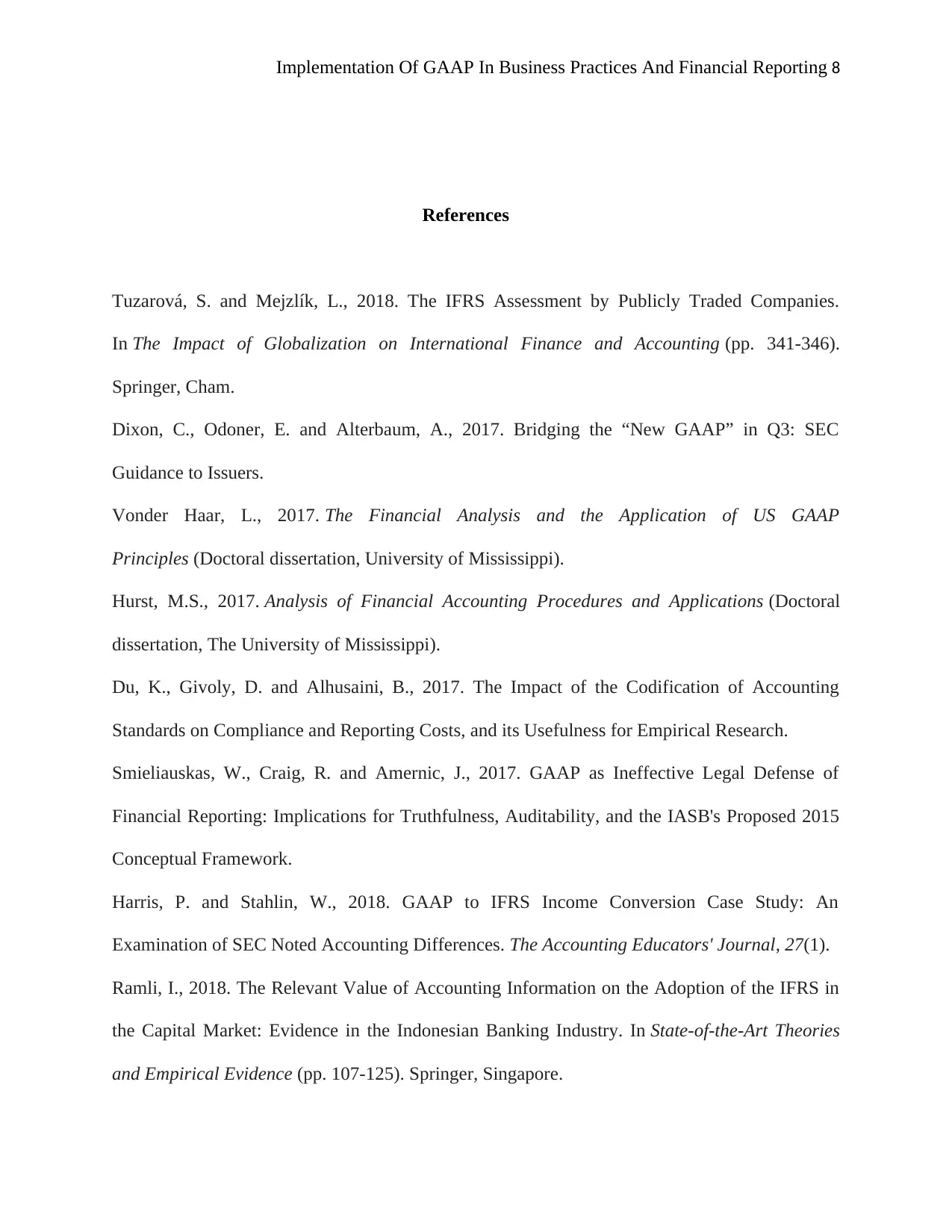
Implementation Of GAAP In Business Practices And Financial Reporting 8
References
Tuzarová, S. and Mejzlík, L., 2018. The IFRS Assessment by Publicly Traded Companies.
In The Impact of Globalization on International Finance and Accounting (pp. 341-346).
Springer, Cham.
Dixon, C., Odoner, E. and Alterbaum, A., 2017. Bridging the “New GAAP” in Q3: SEC
Guidance to Issuers.
Vonder Haar, L., 2017. The Financial Analysis and the Application of US GAAP
Principles (Doctoral dissertation, University of Mississippi).
Hurst, M.S., 2017. Analysis of Financial Accounting Procedures and Applications (Doctoral
dissertation, The University of Mississippi).
Du, K., Givoly, D. and Alhusaini, B., 2017. The Impact of the Codification of Accounting
Standards on Compliance and Reporting Costs, and its Usefulness for Empirical Research.
Smieliauskas, W., Craig, R. and Amernic, J., 2017. GAAP as Ineffective Legal Defense of
Financial Reporting: Implications for Truthfulness, Auditability, and the IASB's Proposed 2015
Conceptual Framework.
Harris, P. and Stahlin, W., 2018. GAAP to IFRS Income Conversion Case Study: An
Examination of SEC Noted Accounting Differences. The Accounting Educators' Journal, 27(1).
Ramli, I., 2018. The Relevant Value of Accounting Information on the Adoption of the IFRS in
the Capital Market: Evidence in the Indonesian Banking Industry. In State-of-the-Art Theories
and Empirical Evidence (pp. 107-125). Springer, Singapore.
References
Tuzarová, S. and Mejzlík, L., 2018. The IFRS Assessment by Publicly Traded Companies.
In The Impact of Globalization on International Finance and Accounting (pp. 341-346).
Springer, Cham.
Dixon, C., Odoner, E. and Alterbaum, A., 2017. Bridging the “New GAAP” in Q3: SEC
Guidance to Issuers.
Vonder Haar, L., 2017. The Financial Analysis and the Application of US GAAP
Principles (Doctoral dissertation, University of Mississippi).
Hurst, M.S., 2017. Analysis of Financial Accounting Procedures and Applications (Doctoral
dissertation, The University of Mississippi).
Du, K., Givoly, D. and Alhusaini, B., 2017. The Impact of the Codification of Accounting
Standards on Compliance and Reporting Costs, and its Usefulness for Empirical Research.
Smieliauskas, W., Craig, R. and Amernic, J., 2017. GAAP as Ineffective Legal Defense of
Financial Reporting: Implications for Truthfulness, Auditability, and the IASB's Proposed 2015
Conceptual Framework.
Harris, P. and Stahlin, W., 2018. GAAP to IFRS Income Conversion Case Study: An
Examination of SEC Noted Accounting Differences. The Accounting Educators' Journal, 27(1).
Ramli, I., 2018. The Relevant Value of Accounting Information on the Adoption of the IFRS in
the Capital Market: Evidence in the Indonesian Banking Industry. In State-of-the-Art Theories
and Empirical Evidence (pp. 107-125). Springer, Singapore.

Implementation Of GAAP In Business Practices And Financial Reporting 9
⊘ This is a preview!⊘
Do you want full access?
Subscribe today to unlock all pages.

Trusted by 1+ million students worldwide
1 out of 9
Related Documents
Your All-in-One AI-Powered Toolkit for Academic Success.
+13062052269
info@desklib.com
Available 24*7 on WhatsApp / Email
![[object Object]](/_next/static/media/star-bottom.7253800d.svg)
Unlock your academic potential
Copyright © 2020–2025 A2Z Services. All Rights Reserved. Developed and managed by ZUCOL.





